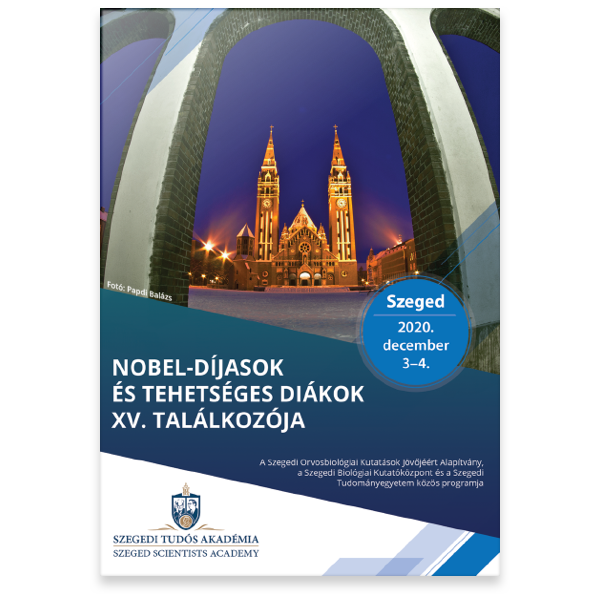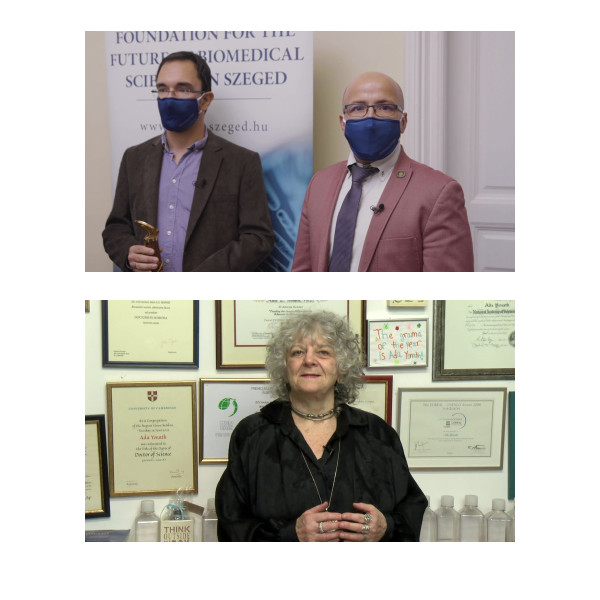NOBEL-DÍJASOK ÉS TEHETSÉGES DIÁKOK XV. TALÁLKOZÓJA
2020. december 3-4.
Üdvözöljük konferenciánkon!
Ez alkalommal sajnos nem köszönthetjük Önöket Szeged gyönyörű városában,
a konferencia teljes egészében online kerül megrendezésre!
Programfüzet
Tekintse meg újra a Konferencia programelemeit!
Díszvendégek
Ismerje meg a konferencia kiemelt vendégeit!

Bert Sakmann
Nobel-díjas német fiziológus
1991-ben Erwin Neher-rel együtt elnyerte az orvostudományi Nobeldíjat a sejtek egyedi ioncsatornáinak működését illető felfedezéseiért és a folt-feszültségzár (patch clamp) méréstechnika kidolgozásáért.
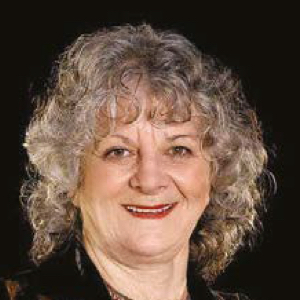
Ada E. Yonath
Nobel-díjas izraeli biokémikus
2009-ben „a riboszóma szerkezetének és működésének kutatásáért” megosztott kémiai Nobel-díjat kapott Venkatraman Ramakrishnan-nal és Thomas A. Steitz-zel közösen.
Meghívott előadók
Ismerje meg a konferencia előadóit!
Talentum-díjas mentorok
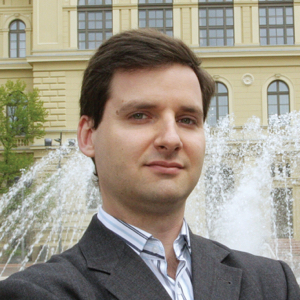
Dr. Berényi Antal
Szegedi Tudományegyetem, Általános Orvostudományi Kar, Élettani Intézet
Oscillotherapeutics: Space and time targeted brain stimulation in epilepsy
2020. december 3. 14:00-14:20
Rhythmic brain activity supports many physiological functions from motor control to cognition. Disruptions of the normal oscillatory brain patterns are commonly observed in neurological and psychiatric disorders including epilepsy, anxiety/trauma-related disorders, major depressive disorder, and many others.
Therefore, these diseases can be considered also as oscillatory defects (‘Oscillopathies’) despite having distinct behavioral manifestations and genetic causes. An increasing number of studies suggest that there is a causal link between these disturbed network oscillations and the symptomatic manifestation of the disorders. Innovative approaches of recording and analysis techniques allowed us to study the pathological oscillations in models of these disorders as possible biomarkers of symptoms. Furthermore, recent advances in brain stimulation technologies enable time- and space-targeted interference with the pathologic oscillations in epilepsy, as possible targets to regulate symptoms. The overarching goal of our decade-long efforts is to establish an on-demand, non-pharmaceutical approach to prevent the development of epileptic seizures. In my talk, I will present the results of our research in intervening epileptic seizures by promptly disrupting pathologic network oscillations using electrical stimulation. Our translational work aiming the use of this technology on human patients will also be highlighted.
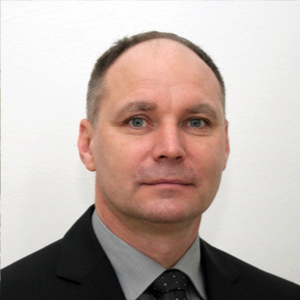
Dr. Haracska Lajos
Szegedi Biológiai Kutatóközpont, Genetikai Intézet
Molecular mechanism of mutagenesis and carcinogenesis
2020. december 3. 14:20-14:40
Our research laboratory focuses on the forces driving the molecular mechanisms of mutagenesis and carcinogenesis. DNA is constantly exposed to exogenous and endogenous agents that cause damage, hindering the activity of the replication machinery. Replication fork stalling may cause strand breaks and chromosomal ...
… rearrangements, leading to genome instability and resulting in early onset aging and eventually cancer. Several DNA damage tolerance pathways have evolved to rescue the stalled replication fork, which do not necessarily repair the lesion but rather facilitate mechanisms that replicate across the damaged segment, e.g., translesion synthesis. Translesion synthesis is error prone, which may lead to mutagenesis and cancer. By contrast, error-free lesion bypass mechanisms maintain a low level of mutagenesis and cancers. One of the most intriguing questions is how decision between these different DNA damage tolerance pathways are made. We have recently identified new regulators that act when replication encounters DNA damage. SPARTAN, one of our recent findings, promotes genomic stability by regulating choices of rescuing the stalled replication fork. Association has been found between mutations in SPARTAN and early onset hepatocellular carcinoma and premature aging. Our results demonstrate that Spartan acts as a protease promoting the replication of DNA-protein crosslink-containing DNA, which may highlight its role in preventing carcinogenesis and aging.
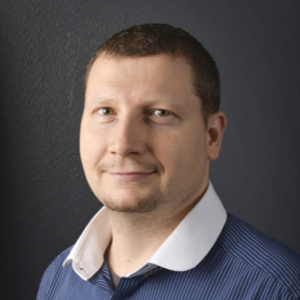
Dr. Horváth Péter
Szegedi Biológiai Kutatóközpont, Biokémiai Intézet
Life beyond the pixels: single-cell analysis using machine learning and image analysis methods
2020. december 3. 14:40-15:00
In this talk I will give an overview of the computational steps in the analysis of a single cell-based large-scale microscopy experiments using deep learning techniques. First, I will present a novel microscopic image correction method designed to eliminate illumination and uneven background effects.
New single-cell image segmentation methods will be presented using differential geometry, energy minimization and deep learning methods (www.nucleaizer.org). I will discuss the Advanced Cell Classifier (ACC) (www.cellclassifier.org), a machine learning software tool capable of identifying cellular phenotypes based on features extracted from the image. It provides an interface for a user to efficiently train machine learning methods to predict various phenotypes. For cases where discrete cell-based decisions are not suitable, we propose a method to use multi-parametric regression to analyze continuous biological phenomena. To improve the learning speed and accuracy, we propose an active learning scheme that selects the most informative cell samples. Our recently developed single-cell isolation methods, based on laser-microcapturing and patch clamping, utilize the selection and extraction of specific cell(s) using the above machine learning models. I will show that we successfully performed DNA and RNA sequencing, dPCR, and targeted electrophysiology measurements on the selected cells.
Finally I will show our results in the COVID-19 fight using deep learning methods (Daly etal Science 2020).
Az Év Talentum-díjasa
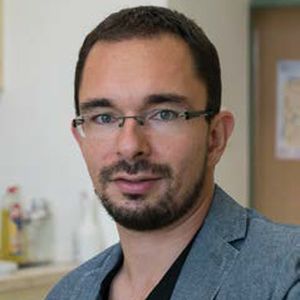
Dr. Nagy László
Szegedi Biológiai Kutatóközpont, Biokémiai Intézet
Comparative genomics for fungal biotechnology
2020. december 3. 16.00-16.20
Society today exerts an ever increasing pressure for finding sustainable solutions for biotechnological challenges. Although used for centuries in various applications, fungi still represent ...
... an unexploited resource for novel biotechnological applications. The wide availability of fungal genomes and de novo genome sequencing gave rise to the field of comparative genomics, which, by analyzing similarities and differences across tens to thousands of genomes, enables the detection of genomic features (e.g. genes, regulatory regions, SNPs) that underlie differences in species traits. In my talk, I illustrate the basic logic of using comparative genomics for computationally predicting the genetic bases of phenotypes. I present examples of using genomics to find gene families that underlie the ability of fungi to decompose wood - such gene families have potential in improving the biofuel industry. I also present our recent results on the origins of fungal multicellularity, one of the key clinically and industrially important traits of fungi, which enabled them to evolve the most efficient strategies for microbial decomposition of complex organic materials on Earth.
Az Év Szent-Györgyi Diákja
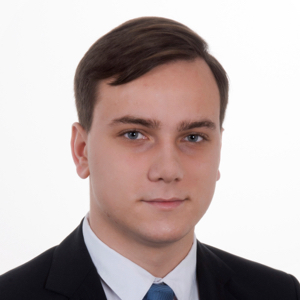
Dobos Dominik
Analog model of the human cardiovascular system
2020. december 3. 15:40-16:00
The aim of the project was to create a system of a model that demonstrates the human blood circulation and auxilliary software which together display the nature of the circulatory system, the pecularities of its operation, its structure and illnesses. The model serves as a demonstration tool to the study material presented by the software. It also shows information based on data provided by various sensors embedded into the model. This information is very similar to what one should expect from the real circulatory system, and thus carry immense value regarding educational purposes.
Az Év Szent-Györgyi Hallgatója
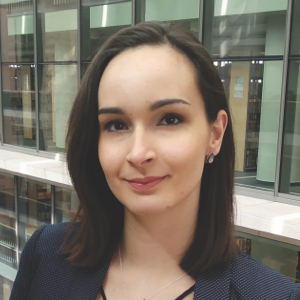
Meszlényi Valéria Éva
Alterations of motor axon terminals in mice due to passive transfer with sera of amyotrophic lateral sclerosis patients with identified mutations
2020. december 3. 16:00-16:20
Introduction: Amyotrophic lateral sclerosis (ALS) is an incurable neurodegenerative disease affecting the motor neurons in the brain and spinal cord, leading to the loss of voluntary muscle function. ALS can be classified as familial or sporadic based on its inheritance. Previously, our research group demonstrated an increase of the calcium level and increase of the number of synaptic vesicles in the motor axon terminals (MATs) of sporadic ALS patients.
These alterations could be conferred to mice via passive transfer of the sera from these patients. In the present experiment we aimed to question the similar effect of the sera from another population of patients, which possess identified mutations.
Methods: Patients with 11 different ALS-related mutations participated in our study. Balb/c mice were injected intraperitoneally with sera of ALS patients or healthy individuals for two days. After the passive transfer, calcium histochemistry was performed and MATs in the interosseus muscles were investigated under electron microscope. Intracellular calcium content and synaptic vesicle number was quantified.
Results: Passive transfer resulted in significant increase of intracellular calcium levels and synaptic vesicle number in the MATs of mice due to the passive transfer of sera from ALS patients with identified mutations, similar to sera from sporadic ALS patients. In addition, ultrastructural signs of degeneration were also observed at the neuro-muscular synapses.
Discussion: Our findings support the unifying hypothesis, that the pathomechanism underlying the identical manifestation of the disease with or without identified mutations is based on a common final pathway, in which calcium increase plays a central role.
